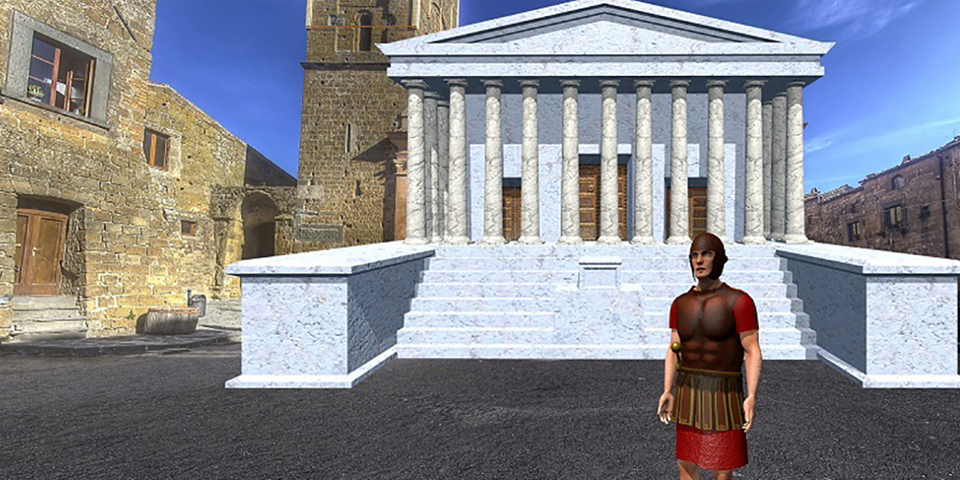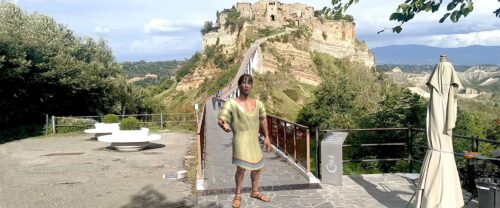Immersive Civita
The Ancient & Recent Tour Operator realized the first Augmented and Mixed Reality Tour of Civita di Bagnoregio. Here you can breathe a magical atmosphere! Visit the charming village of Civita di Bagnoregio in a completely new way! Thanks to the Mixed Reality, you will be able to discover how Civita looked like in past eras. So, you will be catapult back in time. Through the special AR/MR lenses you will be able to observe 3D reconstructions; holograms; as well as interact with it. Learn history while having fun! Five different 3D animate guides, in the form of a hologram, will accompany you on your virtual journey. In fact, at each stage you will be guide by a historical figure of the time. It will be useful for you to know the history; the traditions and legends of this magnificent place. An immersive guided tour; engaging and interactive!
Immersive Civita di Bagnoregio
We are located in the Tuscia area, an area where the Etrurian region once extended. The Etruscans populate the area and founded Civita di Bagnoregio 2500 years ago. Instead, its ancient village dates back to another era, the Roman one.
Civita is one of the most beautiful villages in Italy. One of the most evocative of Upper Tuscia. So much so that his candidacy for UNESCO was approved today. Did you know that Civita di Bagnoregio is also known as “the dying city”? It was the writer Bonaventura Tecchi who addressed her in this way. The reason for this nickname? Certainly because of its particular position. In fact, the city is locate on a gradually eroding hill. Therefore, this feature makes it a truly unique and inimitable place. Discover the history of the town and the cause of its erosion on your virtual visit to Civita di Bagnoregio!
Immersive Civita Mixed Reality
Mixed Reality combines Virtual Reality and Augmented Reality. In short, here is a quick explanation on the difference between these two immersive technologies:
- The first, Virtual Reality, completely immerses the user in a virtual world.
- The second, Augmented Reality, on the contrary, superimposes virtual objects on the real world.
Mixed Reality does both. And it does so through holograms. These, in other words, are generated by a play of light in the device’s lenses. Finally, the user perceives both the real world around and the virtual world with the viewer. The result is the 3D reconstruction of a monument superimpose exactly above it in reality. Furthermore, with a series of hand gestures it will be possible to interact with the holographic characters.
A dip in the past of Civita di Bagnoregio
The virtual path includes ten stages in the past to be discovered! Each stage traces an important piece of the history of Civita di Bagnoregio. Relive the village of Civita in the Etruscan period; then in the Roman one; then Lombard and finally in the medieval one! Guiding you are five historical characters with whom you can interact.
- Velthur: your guide in the flourishing Etruscan period;
- Gaius: the Roman soldier who will guide you in 274 BC;
- Aufret: Lombard governor of Civita di Bagnoregio, he will accompany you from the 7th to the 8th century AD.
- San Bonaventura da Bagnoregio: the patron saint of Civita di Bagnoregio.
- Rosina: artisan peasant of the contemporary era.

Start of the Immersive Civita route
Five historical figures; four different eras; and a journey of ten stages. What are you waiting for? Put on the headset and let yourself be transported back in time with an Immersive Civita!
Civita di Bagnoregio Belvedere: Your immersive visit starts now. You are at the Belvedere, not far from Civita di Bagnoregio. Point from which the city can be seen in all its beauty. Here he puts on the headset and begins the Augmented Reality experience. Listen to the narration, it will explain what factors have led this place to continuous erosion. Now look ahead to its geological evolution over time. A frightening and at the same time fascinating geological phenomenon.
Entrance to Civita di Bagnoregio: The second stage sees the arrival of the historical figure Velthur, the Etruscan. You are between the VIII-VII century BC. and you are at the gates of the city. Attend the foundation of Civita di Bagnoregio. So look at it as it once was on a geological level. For example, there was no need for a bridge to connect it. Since the location was strategic for both defense; both for the means of communication.
Porta Santa Maria: Take a step back in time 10 centuries forward and arrive at the Lombard era. You are now in the 7th-8th century AD. Get to know Aufret, who will show you the changes that have taken place over the centuries. At this time you will notice that the land of Civita di Bagnoregio was already beginning to give way, causing landslides. The historical figure will tell you about the Middle Ages. You will see where the ancient church of San Pietro was located; as well as his seal ring found in that place.
Learn about the various eras of Civita
Piazza Colesanti: You are again with the Lombard governor Aufret in the 7th-8th century AD. In this stage you will discover an interesting legend about Civita di Bagnoregio. The story goes that the city was called Balneum Regis at one point. Literally “king’s bath”. The reason is undoubtedly the presence of a thermal spring with miraculous properties. According to legend, these waters healed wounds and diseases. During the vision of him, the tourist will then see King Agilulf appear with his entourage. You can approach it, walk around it and interact with the characters. Then! Are you ready?
House of Saint Bonaventura: In this phase you will see Saint Bonaventura appear near his house. This is the most significant historical figure for Civita di Bagnoregio. Hear the story he has to tell you. She will talk about his life; of the city; you will see the 3D animation of the Etruscan cave; and finally of the miracle received at the end of his life by St. Francis.
Piazza San Donato: You are now in 264 BC, and your guide will be the Roman soldier Gaius. This, in short, will tell you the story of the conquest of Civita by the Roman Empire. You will see how the city had become; Gaius will explain its urban structure to you; then the square; the holes and their function. Plus, you’ll meet San Bonaventura again, intent on explaining how the citizens broke free from Roman rule.
Ancient Civitas Museum: You will be transported inside the Antica Civitas Museum, a humble house carved into the tuff. Here lived the typical peasants represented by the character of Rosina with her family. You will meet her, and she will lead you to the discovery of a fundamental material for the city: tuff.
Observe Civita and its breathtaking scenery
Etruscan tombs: In this stage you will meet again the Etruscan guide Velthur. You will get to know the Etruscan necropolis with him; its function and its structure. In addition, you will find out what funerary rites were in the period between the 8th and 7th centuries BC.
Bucaione: The Bucaione is a deep tunnel dating back to the Etruscan era. It was originally used to go down to the valley. Last century this passage was enlarged to allow the transit of wagons, but, during the Second World War it certainly served as an excellent hiding place. Unfortunately today, since it is not accessible, it can only be explored through virtual reality.
Garden of the Poets: Finally, the last stage is entirely dedicate to the geological transformation of the Civita badlands. A narrator will tell in detail the main factors that cause their erosion. The action of the rains and periods of drought are certainly the triggering reasons. In short, you will discover the evolution through 4 phases: firstly, Decortication; secondly, Rill; then Gully; and in addition badlands. In conclusion, listen to the narrator and find out more.
